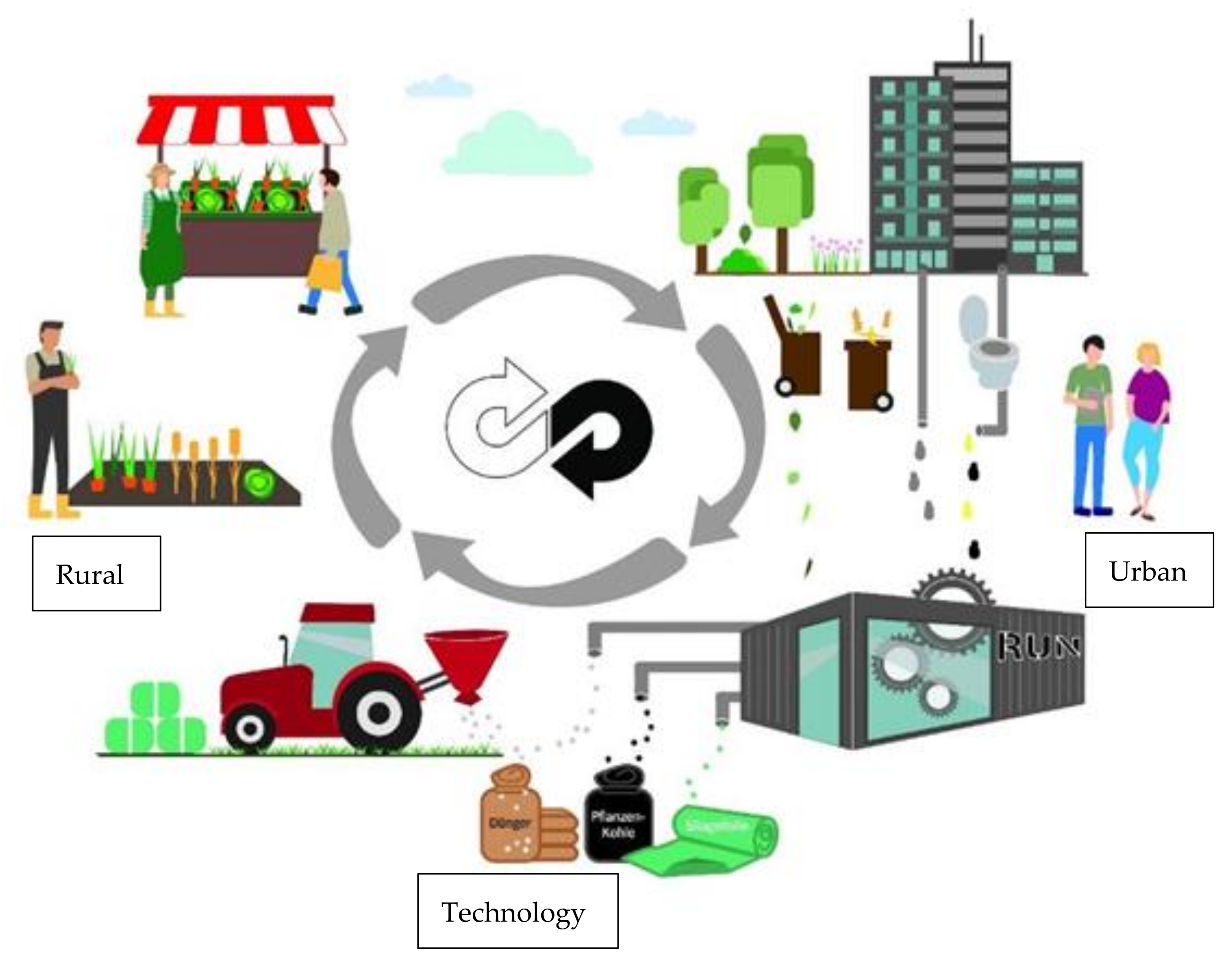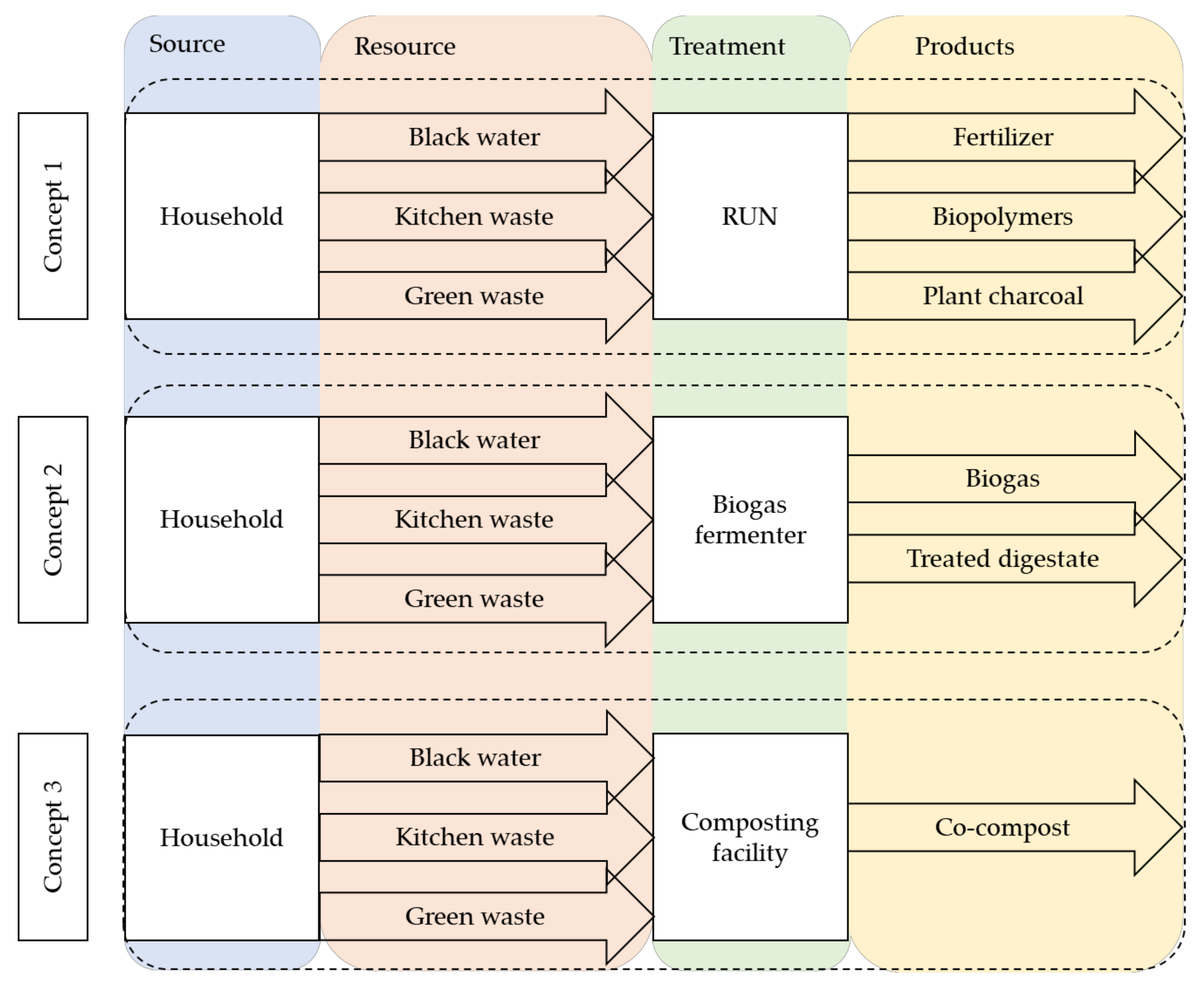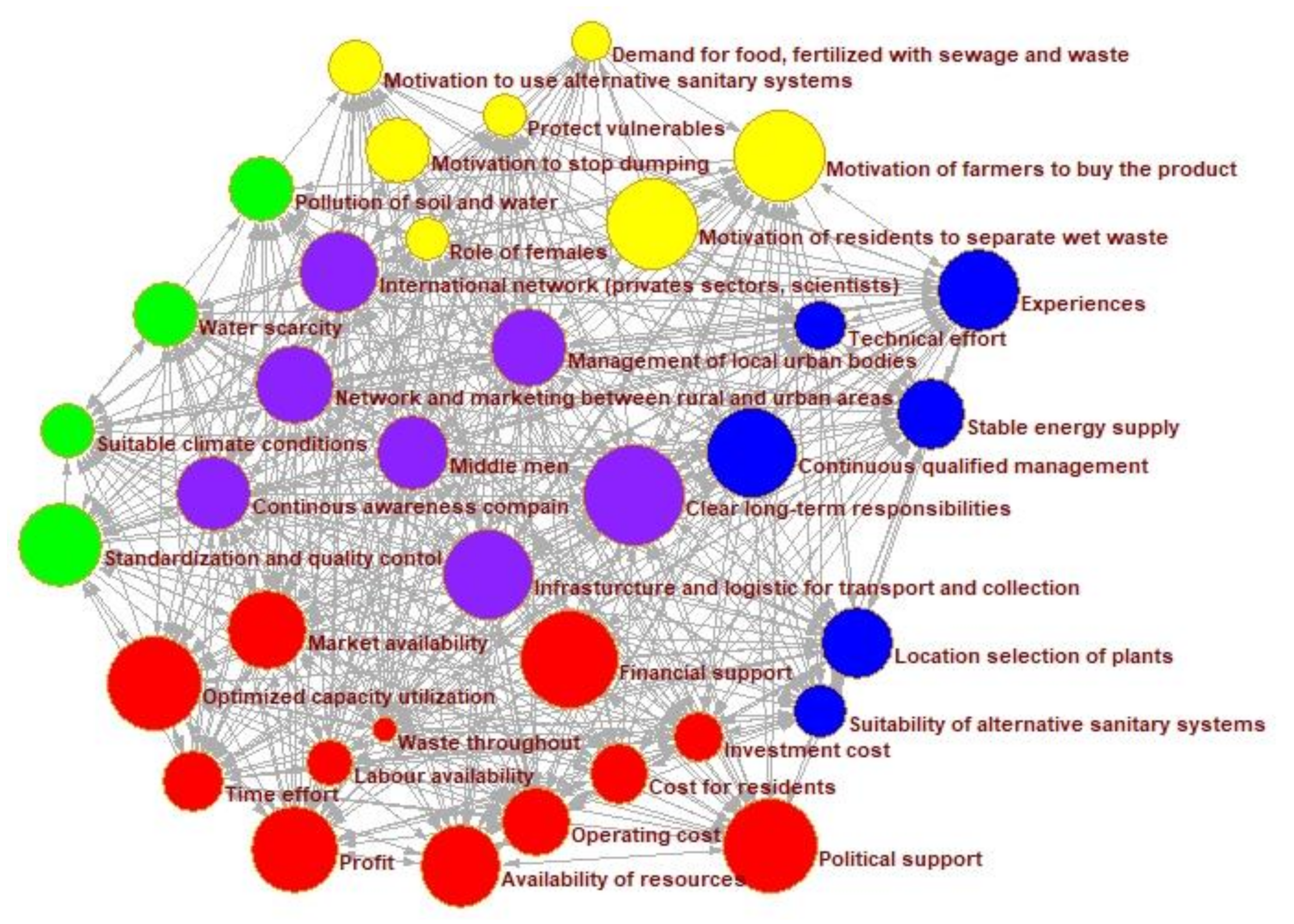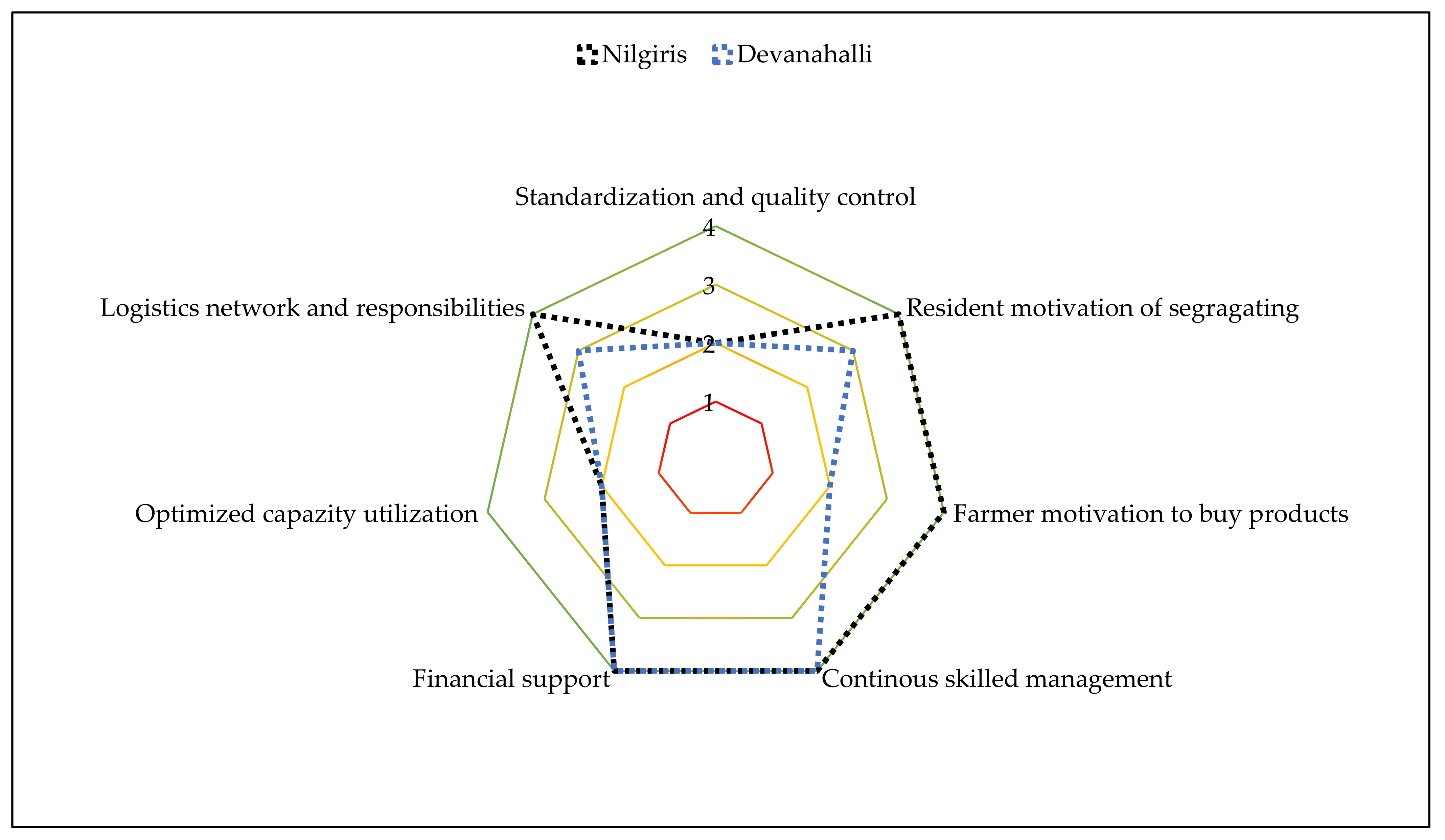Stakeholder Assessment on Closing Nutrient Cycles through Co-Recycling of Biodegradable Household Kitchen Waste and Black Water between Rural and Urban Areas in South India
Abstract
:1. Introduction
1.1. Problem Status
1.2. Relevance
1.3. Research Gap
1.4. Objectives
- Which is currently the most suitable co-recycling concept?
- What are currently the most suitable key indicators for the implementation of such concepts?
- How can these key indicators be assessed?
2. Materials and Methods
2.1. Interviews with Thematic Stakeholders
2.2. Social Network Analysis
2.3. Case Studies
3. Results
3.1. Ecological
Key Indicator: Standardization and Quality Control
3.2. Social
3.2.1. Key Indicator: Motivation of Residents to Separate Wet Waste
3.2.2. Key Indicator: Motivation of Farmers to Buy the Product
3.3. Technical
Key Indicator: Continuous Qualified Management
3.4. Economical
3.4.1. Key Indicator: Financial Support
3.4.2. Key Indicator: Optimized Capacity Utilization
3.5. Connective
Key Indicator: Logistics Network with Clear and Long-Term Responsibilities
4. Discussion
4.1. Potential of Alternative Circular Co-Recycling Concepts
4.2. Importance of the Methodology
4.3. Potential of the Indicators
4.4. Data Quality and Limitations
4.5. Further Research
5. Conclusions
Author Contributions
Funding
Data Availability Statement
Acknowledgments
Conflicts of Interest
References
- Fiksel, J.; Sanjay, P.; Raman, K. Steps toward a resilient circular economy in India. Clean Technol. Environ. Policy 2020, 23, 1–16. [Google Scholar] [CrossRef]
- The World Bank. Country Data - India. Available online: https://data.worldbank.org/country/india (accessed on 30 June 2022).
- Planning Commission. Report of the Task Force on Waste to Energy (Volume I, II & III); Constitutions of tasks force on waste to energy projects, PPP & Infrastructure Division; Planning Commission: New Delhi, India.
- Gill, K.; Verma, I. Circular Economy: A Review of Global Practices and Initiatives with Special Reference to India. Focus 2021, 8, 187–205. [Google Scholar] [CrossRef]
- Kumar, S.; Smith, S.R.; Fowler, G.; Velis, C.; Kumar, S.J.; Arya, S.; Rena Kumar, R.; Cheeseman, C. Challenges and opportunities associated with waste management in India. R. Soc. Open Sci. 2017, 4, 160764. [Google Scholar] [CrossRef] [PubMed] [Green Version]
- Mihelcic, J.R.; Fry, L.M.; Shaw, R. Global potential of phosphorus recovery from human urine and feces. Chemosphere 2011, 84, 832–839. [Google Scholar] [CrossRef] [PubMed]
- Sugihara, R. Reuse of Human Excreta in Developing Countries. Consilience 2020, 22, 58–64. [Google Scholar]
- Speier, C.J.; Mondal, M.M.; Weichgrebe, D. Evaluation of compositional characteristics of organic waste shares in municipal solid waste in fast-growing metropolitan cities of India. J. Mater. Cycles Waste Manag. 2018, 20, 2150–2162. [Google Scholar] [CrossRef]
- Lansche, J.; Awiszus, S.; Latif, S.; Müller, J. Potential of Biogas Production from Processing Residues to Reduce Environmental Impacts from Cassava Starch and Crisp Production—A Case Study from Malaysia. Appl. Sci. 2020, 10, 2975. [Google Scholar] [CrossRef]
- FAO. India at a Glace. Available online: https://www.fao.org/india/fao-in-india/india-at-a-glance/en/ (accessed on 9 December 2021).
- Minale, M.; Worku, T. Anaerobic co-digestion of sanitary wastewater and kitchen solid waste for biogas and fertilizer production under ambient temperature: Waste generated from condominium house. Int. J. Environ. Sci. Technol. 2014, 11, 509–516. [Google Scholar] [CrossRef] [Green Version]
- Hettiarachchi, H.; Caucci, S.; Schwärzel, K. Organic Waste Composting through Nexus Thinking; Springer International Publishing: Cham, Switzerland, 2020; ISBN 978-3-030-36282-9. [Google Scholar]
- Masullo, A. Organic wastes management in a circular economy approach: Rebuilding the link between urban and rural areas. Ecol. Eng. 2017, 101, 84–90. [Google Scholar] [CrossRef]
- Friedrich, J.; Poganietz, W.-R.; Lehn, H. Life-cycle assessment of system alternatives for the Water-Energy-Waste Nexus in the urban building stock. Resour. Conserv. Recycl. 2020, 158, 104808. [Google Scholar] [CrossRef]
- Remy, C.; Ruhland, A. Ecological Assessment of Alternative Sanitation Concepts with Life Cycle Assessment: Final Report for Subtask 5 of the Demonstration Project “Sanitation Concepts for Separate Treatment of Urine, Faeces and Greywater “ (SCST); Technical University Berlin: Berlin, Germany, 2006. [Google Scholar]
- Schroeder, P.; Anggraeni, K.; Weber, U. The Relevance of Circular Economy Practices to the Sustainable Development Goals. J. Ind. Ecol. 2019, 23, 77–95. [Google Scholar] [CrossRef] [Green Version]
- United Nations. Transforming our World: The 2030 Agenda for Sustainable Development. Available online: sustainabledevelopmentgoals.un.org (accessed on 21 April 2022).
- RUN—Rural Urban Nutrient Partnership. RUN in Images. Available online: https://www.run-projekt.de/erklaergrafiken (accessed on 29 March 2022).
- Mayring, P. Qualitative Content Analysis: A Step-by-Step Guide; SAGE Publications Ltd: Thousand Oaks, CA, USA, 2022; ISBN 9781529701975. [Google Scholar]
- Farsi, A. Migranten auf dem Weg zur Elite? Springer Fachmedien Wiesbaden: Wiesbaden, Germany, 2014; ISBN 978-3-658-01563-3. [Google Scholar]
- Özesmi, U.; Özesmi, S.L. Ecological models based on people’s knowledge: A multi-step fuzzy cognitive mapping approach. Ecol. Model. 2004, 176, 43–64. [Google Scholar] [CrossRef] [Green Version]
- Müller, S.; Backhaus, N.; Nagabovanalli, P.; Abiven, S. A social-ecological system evaluation to implement sustainably a biochar system in South India. Agron. Sustain. Dev. 2019, 39, 326. [Google Scholar] [CrossRef]
- Consortium for DEWATS Dissemination (CDD) Society. Bengaluru. Insights from Faecal Sludge Management in Devanahalli: Five Years of Operations. Available online: https://cddindia.org/wp-content/uploads/Insights-from-Devanahalli-December-2020.pdf (accessed on 10 January 2022).
- WASTE. Circular Economy Model with Black and Greywater Recycling in India. Available online: https://www.susana.org/_resources/documents/default/3-3811-7-1583753631.pdf (accessed on 10 January 2022).
- Rural Development Organisation (RDO Trust). Faecal Sludge Treatment plants in Ketty and Adhigaratty Panchayats in Nilgiris District. Available online: https://rdotrust.org/?page_id=495 (accessed on 10 January 2022).
- Gupta, M.; Srivastava, M.; Agrahari, S.K.; Detwal, P. Waste to energy technologies in India: A review. JEES 2018, 6, 29–35. [Google Scholar] [CrossRef]
- Vogt, R.; Stubbusch, A.; Lakshmi, K.V.; Arora, K.; Shekhar, A.R.; Chandran, K.; Pravinjith, K.P.; Khanam, A. Ressourcen- und Klimaschutz durch Integrierte Abfallwirtschaftsprojekte in Schwellen- und Entwicklungsländern—Beispiel Indien; Umweltforschungsplan des Bundesministeriums für Umwelt, Naturschutz und nukleare Sicherheit: Berlin, Germany, 2019. [Google Scholar]
- Krause, A.; Rotter, V. Recycling Improves Soil Fertility Management in Smallholdings in Tanzania. Agriculture 2018, 8, 31. [Google Scholar] [CrossRef] [Green Version]
- Krithika, D.; Thomas, A.R.; Iyer, G.R.; Kranert, M.; Philip, L. Spatio-temporal variation of septage characteristics of a semi-arid metropolitan city in a developing country. Environ. Sci. Pollut. Res. Int. 2017, 24, 7060–7076. [Google Scholar] [CrossRef]
- Thomas, A.R.; Kranert, M.; Philip, L. In-vessel co-composting—A rapid resource recovery option for septage treatment in Indian cities. J. Water Sanit. Hyg. Dev. 2018, 8, 688–697. [Google Scholar] [CrossRef]
- Han, W.; Zhao, Y.; Chen, H. Study on Biogas Production of Joint Anaerobic Digestion with Excess Sludge and Kitchen Waste. Procedia Environ. Sci. 2016, 35, 756–762. [Google Scholar] [CrossRef]
- Wendland, C. Anaerobic Digestion of Blackwater and Kitchen Refuse; Technische Universität Hamburg: Hamburg, Germany, 2009. [Google Scholar]
- Wang, H.; Li, Z.; Zhou, X.; Wang, X.; Zuo, S. Anaerobic Co-Digestion of Kitchen Waste and Blackwater for Different Practical Application Scenarios in Decentralized Scale: From Wastes to Energy Recovery. Water 2020, 12, 2556. [Google Scholar] [CrossRef]
- Remy, C. Life Cycle Assessment of Cnventional and Source-Separation Systems for Urban Wastewater Management; Technischen Universität Berlin: Berlin, Germany, 2010. [Google Scholar]
- Surie, G. Achieving Sustainability: Insights from Biogas Ecosystems in India. Agriculture 2017, 7, 15. [Google Scholar] [CrossRef] [Green Version]
- Pan, S.-Y.; Du, M.A.; Huang, I.-T.; Liu, I.-H.; Chang, E.-E.; Chiang, P.-C. Strategies on implementation of waste-to-energy (WTE) supply chain for circular economy system: A review. J. Clean. Prod. 2015, 108, 409–421. [Google Scholar] [CrossRef]
- Rambaree, K.; Sundström, A.; Wang, Z.; Wright, S.A.I. Qualitative Stakeholder Analysis for a Swedish Regional Biogas Development: A Thematic Network Approach. Sustainability 2021, 13, 8003. [Google Scholar] [CrossRef]
- Mittal, S.; Ahlgren, E.O.; Shukla, P.R. Barriers to biogas dissemination in India: A review. Energy Policy 2018, 112, 361–370. [Google Scholar] [CrossRef]
- Kannan, P.; Arunachalam, P.; Prabukumar, G.; Govindaraj, M. Biochar an alternate option for crop residues and solid waste disposal and climate change mitigation. Afr. J. Agric. Res. 2013, 8, 2403–2412. [Google Scholar]
- Gell, K.; Ruijter, F.; Kuntke, P.; De Graaff, M.; Smit, A.L. Safety and Effectiveness of Struvite from Black Water and Urine as a Phosphorus Fertilizer. JAS 2011, 3, 67. [Google Scholar] [CrossRef]
- Luthra, A. Waste-to-Energy and Recycling: Competing Systems of Waste Management in Urban India. Econ. Political Wkly. 2017, 52, 51. [Google Scholar]
- Gall, M.; Wiener, M.; Chagas de Oliveira, C.; Lang, R.W.; Hansen, E.G. Building a circular plastics economy with informal waste pickers: Recyclate quality, business model, and societal impacts. Resour. Conserv. Recycl. 2020, 156, 104685. [Google Scholar] [CrossRef]
- Hande, S. The informal waste sector: A solution to the recycling problem in developing countries Field Actions Science Reports. J. Field Actions 2019, 28–35. [Google Scholar]
- Yukalang, N.; Clarke, B.; Ross, K. Solid Waste Management Solutions for a Rapidly Urbanizing Area in Thailand: Recommendations Based on Stakeholder Input. Int. J. Environ. Res. Public Health 2018, 15, 1302. [Google Scholar] [CrossRef] [Green Version]
- Moktadir, M.A.; Kumar, A.; Ali, S.M.; Paul, S.K.; Sultana, R.; Rezaei, J. Critical success factors for a circular economy: Implications for business strategy and the environment. Bus. Strategy Environ. 2020, 29, 3611–3635. [Google Scholar] [CrossRef]
- Mallory, A.; Akrofi, D.; Dizon, J.; Mohanty, S.; Parker, A.; Rey Vicario, D.; Prasad, S.; Welivita, I.; Brewer, T.; Mekala, S.; et al. Evaluating the circular economy for sanitation: Findings from a multi-case approach. Sci. Total Environ. 2020, 744, 140871. [Google Scholar] [CrossRef]
- Kamble, C.B.; Raju, R.; Vishnu, R. An Awareness Study on Circular Economy in India. Gedrag Organ. Rev. 2020, 33, 2559–2569. [Google Scholar] [CrossRef]
- Sekher, M. Keeping Our Cities Clean: Urban Solid Waste Management in Karnataka. J. Soc. Econ. Dev. 2004, 6, 159. [Google Scholar]
- Sabki, M.H.; Lee, C.T.; Bong, C.P.C.; Klemens, J.J. A review on the economic feasibility of composting for organic waste management in Asian countries. Chem. Eng. Trans. 2018, 70, 49–54. [Google Scholar]
- Patwa, N.; Sivarajah, U.; Seetharaman, A.; Sarkar, S.; Maiti, K.; Hingorani, K. Towards a circular economy: An emerging economies context. J. Bus. Res. 2021, 122, 725–735. [Google Scholar] [CrossRef]




| Scale | Value | Answers of Stakeholders |
|---|---|---|
| 1 | Insufficient | The criterion does not exist or is the reason for the failure of the concept. |
| 2 | Improvable | The criterion is seen as a major challenge and a change is necessary for a successful continuation of the concept. |
| 3 | Good | The criterion is satisfactorily met, but improvement is aimed. |
| 4 | Very good | The criterion is met and is not perceived as a challenge. |
| Category | Key Indicator | Assessment Criterion |
|---|---|---|
| Ecological | Standardization and quality control | Measured values of the sales products and the wastewater after treatment in relation to limit values and definitions of specific measures if exceeded |
| Social | Motivation of residents to separate wet waste | Rate of segregation of wet (organic) waste |
| Motivation of farmers to buy the product | Share of informed farmers and farmers who buy the product regularly | |
| Technical | Continuous qualified management | Employee satisfaction and dealing with operating and management problems |
| Economical | Financial support | Assessment of the government support of the entire supply chain |
| Optimized capacity utilization | Efficiency of capacity utilization | |
| Connective | Logistics network and clear long-term responsibilities | Clear responsibilities at state, municipal and operational level, and the possibilities to resolve stagnations in the supply chain |
| Category | Unit | Devanahalli | Nilgiris |
|---|---|---|---|
| Kitchen waste | t·a−1 | 540 | 2120 |
| Green waste | t·a−1 | 108 | - |
| Black water | m³·a−1 | 840 | 534 |
| Compost | t·a−1 | 33 | 522 |
Publisher’s Note: MDPI stays neutral with regard to jurisdictional claims in published maps and institutional affiliations. |
© 2022 by the authors. Licensee MDPI, Basel, Switzerland. This article is an open access article distributed under the terms and conditions of the Creative Commons Attribution (CC BY) license (https://creativecommons.org/licenses/by/4.0/).
Share and Cite
Fendel, V.; Kranert, M.; Maurer, C.; Garcés-Sánchez, G.; Huang, J.; Ramakrishna, G. Stakeholder Assessment on Closing Nutrient Cycles through Co-Recycling of Biodegradable Household Kitchen Waste and Black Water between Rural and Urban Areas in South India. Recycling 2022, 7, 49. https://doi.org/10.3390/recycling7040049
Fendel V, Kranert M, Maurer C, Garcés-Sánchez G, Huang J, Ramakrishna G. Stakeholder Assessment on Closing Nutrient Cycles through Co-Recycling of Biodegradable Household Kitchen Waste and Black Water between Rural and Urban Areas in South India. Recycling. 2022; 7(4):49. https://doi.org/10.3390/recycling7040049
Chicago/Turabian StyleFendel, Veronika, Martin Kranert, Claudia Maurer, Gabriela Garcés-Sánchez, Jingjing Huang, and Girija Ramakrishna. 2022. "Stakeholder Assessment on Closing Nutrient Cycles through Co-Recycling of Biodegradable Household Kitchen Waste and Black Water between Rural and Urban Areas in South India" Recycling 7, no. 4: 49. https://doi.org/10.3390/recycling7040049
APA StyleFendel, V., Kranert, M., Maurer, C., Garcés-Sánchez, G., Huang, J., & Ramakrishna, G. (2022). Stakeholder Assessment on Closing Nutrient Cycles through Co-Recycling of Biodegradable Household Kitchen Waste and Black Water between Rural and Urban Areas in South India. Recycling, 7(4), 49. https://doi.org/10.3390/recycling7040049






